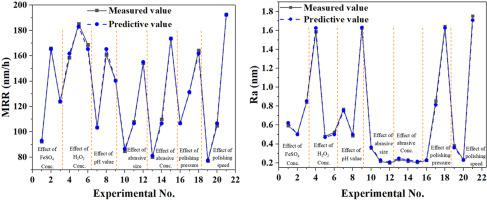Precision Engineering ( IF 3.6 ) Pub Date : 2021-04-24 , DOI: 10.1016/j.precisioneng.2021.04.012 Jiayun Deng , Qixiang Zhang , Jiabin Lu , Qiusheng Yan , Jisheng Pan , Run Chen

|
Chemical mechanical polishing (CMP) is a common method for realising the global planarisation and polishing of single-crystal SiC and other semiconductor substrates. The strong oxidant hydroxyl radicals (·OH) generated by the Fenton reaction can effectively oxidise and corrode the SiC substrate, and are thus used to improve the material removal rate (MRR) and surface roughness (Ra) after polishing of SiC during CMP. Therefore, it is necessary to study the material removal mechanism in detail. Based on the modified Preston equation, the effects of the CMP process parameters on the MRR and Ra after polishing of SiC and their relationship were studied, and a prediction model of the CMP process parameters, MRR, and Ra after polishing was also established based on a back-propagation neural network. The MRR initially increased and then decreased, and the Ra after polishing initially decreased and then increased, with increasing FeSO4 concentration, H2O2 concentration, and pH value. The MRR continuously increased with increasing abrasive particle size, abrasive concentration, polishing pressure, and polishing speed. However, the Ra continuously decreased with increasing abrasive particle size and abrasive concentration, increased with increasing polishing pressure, and initially decreased and then increased with increasing polishing speed. The established prediction model could accurately predict the relationship between the process parameters, MRR and Ra after polishing in CMP (relative prediction error of less than 10%), which could provide a theoretical basis for CMP of SiC.
中文翻译:

反向传播神经网络预测单晶SiC化学机械抛光的表面粗糙度和材料去除率
化学机械抛光(CMP)是实现单晶SiC和其他半导体衬底的整体平面化和抛光的常用方法。通过芬顿反应产生的强氧化剂羟基(·OH)可以有效地氧化和腐蚀SiC衬底,因此可用于提高CMP抛光SiC后的材料去除率(MRR)和表面粗糙度(Ra)。因此,有必要详细研究材料去除机理。基于修正的Preston方程,研究了CMP工艺参数对SiC抛光后MRR和Ra的影响及其关系,并建立了基于CMP的抛光工艺CMP参数,MRR和Ra的预测模型。反向传播神经网络。MRR最初增加然后减少,4浓度,H 2 O 2浓度和pH值。随着磨料粒度,磨料浓度,抛光压力和抛光速度的增加,MRR持续增加。然而,Ra随着磨料粒度和磨料浓度的增加而连续降低,随抛光压力的增加而增加,并随着抛光速度的增加而先减小然后增加。建立的预测模型可以准确预测CMP抛光后的工艺参数,MRR和Ra之间的关系(相对预测误差小于10%),可以为SiC的CMP提供理论依据。


























 京公网安备 11010802027423号
京公网安备 11010802027423号